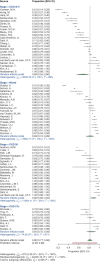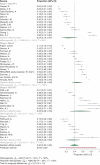Polypharmacy in Patients with CKD: A Systematic Review and Meta-Analysis
- PMID: 38661553
- PMCID: PMC11219116
- DOI: 10.34067/KID.0000000000000447
Polypharmacy in Patients with CKD: A Systematic Review and Meta-Analysis
Abstract
Key Points:
The prevalence of polypharmacy in patients with CKD was over 80%.
Polypharmacy was highest in patients with a kidney transplant and those receiving dialysis.
Polypharmacy is associated with worse clinical outcomes, lower quality of life, and medication-related problems in patients with CKD.
Background: Despite the high prevalence of polypharmacy in patients with CKD, the extent of polypharmacy across patients with (different stages of) CKD, as well as the association with clinical outcomes remains unknown. This systematic review aimed to evaluate the prevalence of polypharmacy in (different subgroups of) patients with CKD and assess the association between polypharmacy and patient-important outcomes.
Methods: MEDLINE, Embase, and the Cochrane Library were searched from inception until July 2022. Studies that reported the prevalence of polypharmacy, medication use, or pill burden in patients with CKD (including patients receiving dialysis and kidney transplant recipients) and their association with patient-important outcomes (i.e., mortality, kidney failure, quality of life [QoL], and medication nonadherence) were included. Two reviewers independently screened title and abstract and full texts, extracted data, and assessed risk of bias. Data were pooled in a random-effects single-arm meta-analysis.
Results: In total, 127 studies were included (CKD 3–5 n=39, dialysis: n=38, kidney transplant n=13, different CKD stages n=37). The pooled prevalence of polypharmacy, based on 63 studies with 484,915 patients, across all patients with CKD was 82% (95% confidence interval, 76% to 86%), and the pooled mean number of prescribed medications was 9.7 (95% confidence interval, 8.4 to 11.0). The prevalence of polypharmacy was higher in patients who received dialysis or a kidney transplant compared with patients with CKD 3–5 but did not differ between studies with regards to region or patients' mean age or sex. In patients with CKD, polypharmacy was associated with a higher risk of all-cause mortality, kidney failure, faster eGFR decline, lower QoL, and higher medication nonadherence, adverse drug reactions, and potentially inappropriate medications.
Conclusions: The prevalence of polypharmacy in patients with CKD was over 80%, and highest in patients with a kidney transplant and those receiving dialysis. No causes of heterogeneity were identified, indicating that polypharmacy is an issue for all patients with CKD. Polypharmacy is associated with worse clinical outcomes, lower QoL, and medication-related problems in patients with CKD.
Clinical Trial registry name and registration number:: PROSPERO (CRD42022331941).
Conflict of interest statement
Disclosure forms, as provided by each author, are available with the online version of the article at
Figures




References
Publication types
MeSH terms
LinkOut - more resources
Full Text Sources
Medical
Research Materials
Miscellaneous

